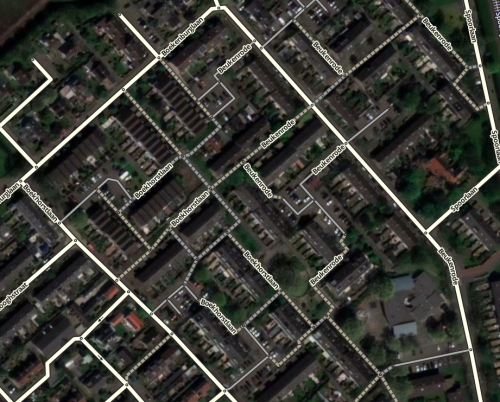Geen bewerkingssamenvatting |
Geen bewerkingssamenvatting |
||
| (10 tussenliggende versies door dezelfde gebruiker niet weergegeven) | |||
| Regel 1: | Regel 1: | ||
{{TopLine}} | {{TopLine}} | ||
<languages /><translate> | <languages /><translate> | ||
[[Category:Editing aspects]] | |||
[[Category:Street]] | |||
== | ==Locking niveau van niet-berijdbare wegen== <!--T:1--> | ||
<!--T:2--> | |||
Het standaard [[Walking trail|WT]]/[[Pedestrian Boardwalk|PB]] locking niveau is '''L1''', behalve wanneer de segmenten deel uitmaken van een complexe routestructuur. Is dat zo, dan moeten deze gelockt worden op '''L3'''. <br /> | |||
<br /> | <br /> | ||
Een complexe routestructuur verwijst naar de rol die [[Non-drivable roads|niet-berijdbare wegen]] spelen in de routering naar bestemmingen: waar het loskoppelen van een [[Walking trail|WT]] of een [[Pedestrian Boardwalk|PB]] kan leiden tot een minder gunstig routeringseindpunt. Sinds de introductie van [[Parking Lot Place|parkeerplaats]] suggesties op basis van looptijd, is het belangrijk om [[Pedestrian Boardwalk|PB]]'s aan te sluiten. <br /> | |||
<br /> | <br /> | ||
[[file:Complex-non-drivable-roads.png|500px]] | |||
</translate> | </translate> | ||
__NOTOC__ | __NOTOC__ | ||
{{Bottomline}} | {{Bottomline}} | ||
Huidige versie van 24 dec 2022 om 10:55
Locking niveau van niet-berijdbare wegen
Het standaard WT/PB locking niveau is L1, behalve wanneer de segmenten deel uitmaken van een complexe routestructuur. Is dat zo, dan moeten deze gelockt worden op L3.
Een complexe routestructuur verwijst naar de rol die niet-berijdbare wegen spelen in de routering naar bestemmingen: waar het loskoppelen van een WT of een PB kan leiden tot een minder gunstig routeringseindpunt. Sinds de introductie van parkeerplaats suggesties op basis van looptijd, is het belangrijk om PB's aan te sluiten.
